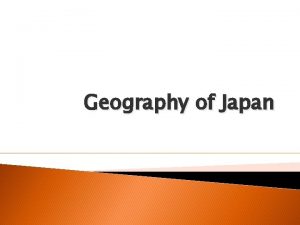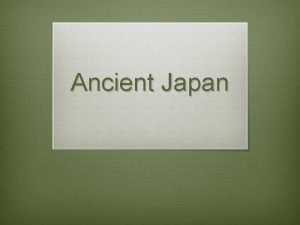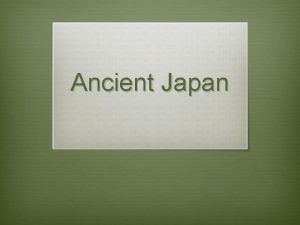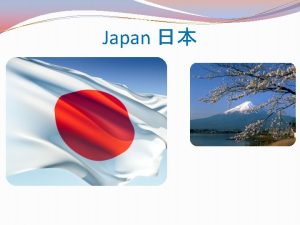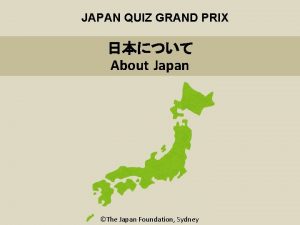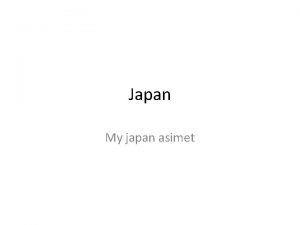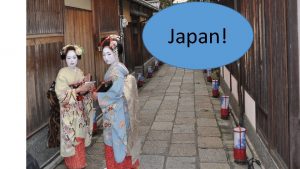Geography of Japan The Geography of Japan Japan














- Slides: 14

Geography of Japan

The Geography of Japan � Japan Hokkaido is an archipelago—a chain of islands is made up of four main islands: � Japan Honshu Shikoku Kyushu ◦ ◦ Kyushu Shikoku Honshu Hokkaido

The Geography of Japan � Japan is separated from continental Asia by the Sea of Japan (or East Sea) � The islands of Japan are volcanic islands—which means Japan has a mountainous terrain ◦ Nearly 72% of Japan is considered mountainous � While Japan was isolated for much of its early history, its close proximity to China and Korea allowed for cultural diffusion

Map of China, Japan, and Korea 1) 4 2) 7 6 5 3) 3 4) 2 1 5) 6) 7) Key:

Map of China, Japan, and Korea Key: 1) Kyushu 2) Shikoku 3) Honshu 4) Hokkaido 4 7 6 5 3 2 1 5) 6) 7) Korea Sea of Japan China

Chinese Influence on Japan

Chinese Influence on Japan � Early on Japan isolated itself from China but gradually became sinicized* ◦ Sinification=adopting Chinese culture � Buddhism spread from China and Korea to Japan � The Japanese adopted the Chinese alphabet

Chinese Influence on Japan � Chinese pavilions influenced the Japanese architectural design of the Pagoda � Confucianism was adopted to help run the government ◦ Japan was originally organized into clans that often fought ◦ Chinese influence strengthened Japanese imperialism ◦ The Japanese emperor was seen as divine

Examples of Sinification: Chinese Alphabet Chinese Pavilion Japanese Alphabet Japanese Pagoda

Religion in Japan

Shinto (Shintoism) � Shinto Japan is the ethnic religion of ◦ It is concerned with the creation of Japan and the Japanese people � Shinto was also the state religion of Japan ◦ The emperor was divine and worshiped literally means “the way of the gods” and is both polytheistic and animistic* � Shinto ◦ Animism is the belief in natural spirits (i. e. forests, mountains, rivers, animals, etc. )

Shinto (Shintoism) � The spirits worshiped in Shinto are known as kami ◦ Kami= spirits in nature and ancestral spirits � In Shinto the people and kami occupy the same realm � There are shrines and sites were the natural and supernatural intersect and the kami are worshiped ◦ Torii’s are gates that mark the entrance to sacred sites (the symbol of Shinto)

Buddhism � Buddhism was also practiced in Japan (after it spread from China and Korea) � In Japan Buddhism and Shinto coexisted ◦ Meaning people practiced aspects of both and identified as both

Buddhism � Today the most common form of Buddhism in Japan is Zen Buddhism (or Japanese Zen) � Zen focuses on reaching enlightenment through regular meditation (known as zazen) ◦ Enlightenment does not come from religious doctrine or worship but through personal experience and a teacher (a bodhisattva)
 Thế nào là mạng điện lắp đặt kiểu nổi
Thế nào là mạng điện lắp đặt kiểu nổi Mật thư anh em như thể tay chân
Mật thư anh em như thể tay chân Lời thề hippocrates
Lời thề hippocrates Vẽ hình chiếu đứng bằng cạnh của vật thể
Vẽ hình chiếu đứng bằng cạnh của vật thể Tư thế worm breton là gì
Tư thế worm breton là gì Quá trình desamine hóa có thể tạo ra
Quá trình desamine hóa có thể tạo ra Sự nuôi và dạy con của hổ
Sự nuôi và dạy con của hổ Các châu lục và đại dương trên thế giới
Các châu lục và đại dương trên thế giới Dạng đột biến một nhiễm là
Dạng đột biến một nhiễm là điện thế nghỉ
điện thế nghỉ Bổ thể
Bổ thể Biện pháp chống mỏi cơ
Biện pháp chống mỏi cơ Làm thế nào để 102-1=99
Làm thế nào để 102-1=99 Thiếu nhi thế giới liên hoan
Thiếu nhi thế giới liên hoan Tia chieu sa te
Tia chieu sa te















